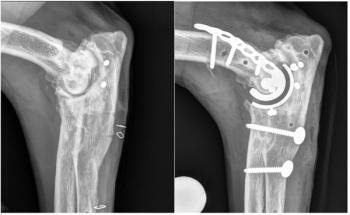
Equine joint osteoarthritis (Sponsored by Bayer HealthCare Animal Health)
Early detection and treatment are the cornerstones of successful management of osteoarthritis, and hyaluronate sodium is an important part of that treatment.
Equine non-infectious synovitis associated with osteoarthritis can be devastating to both the horse and owner. It can also be difficult for the equine practitioner to treat. Early detection and treatment are the cornerstones of successful management of osteoarthritis, and hyaluronate sodium is an important part of that treatment.
Hyaluronate sodium (hyaluronic acid) is a normal joint fluid and cartilage component. It decreases production of the mediators of inflammation within the joint. Hyaluronic acid also lubricates and protects the joint cartilage and synovial membrane.2 Legend® (hyaluronate sodium) Injectable Solution (Bayer Animal Health) is produced by a bio-fermentation process and purified through a 12-step micro-filtration system.
Safety
Because of its purity, Legend can be administered intravenously or intra-articularly—the only FDA-approved joint therapy product labeled for both routes.
Intravenous administration alleviates the need for repeated intra-articular injections in horses and the associated complications of joint infection, trauma, and reaction. It also ensures a rapid onset of action in multiple joints.
Efficacy
Is Legend effective? In field studies, clinical improvement was judged to be excellent or good in 90 percent of horses with lameness that were treated with intravenous Legend.1
In addition, clinical improvement was judged to be excellent or good in 96 percent of horses treated with intra-articular Legend.
Additional studies have corroborated these results as well.Researchers at Colorado State University evaluated the use of intravenous hyaluronate (Legend) on carpal joints in exercising horses after arthroscopic surgery and osteochondral fragmentation.3 In this study, 12 clinically normal horses underwent osteochondral fragmentation of the distal aspect of one radiocarpal bone to simulate naturally occurring osteochondral fragmentation. Six of the horses were treated with 40 mg hyaluronate intravenously and the other six with saline solution (placebo) intravenously once a week for three consecutive weeks on days 13, 20, and 27 after surgery. The horses were exercised on a treadmill five days a week beginning at 15 days and ending 72 days after surgery. Lameness examinations were performed on the horses on day 72 after surgery; they were graded on a scale of 0 to 5 for severity according to American Association of Equine Practitioners (AAEP) guidelines. Synovial fluid samples were evaluated from each middle carpal joint, measuring total protein, inflammatory cell, hyaluronate, glycosaminoglycan, and prostaglandin E2 concentrations. Synovial membrane and articular cartilage were evaluated histologically.
Results
How did the horses respond? In the forelimbs with osteochondral fragments, horses treated with hyaluronate intravenously had lower lameness scores (Figure 1), significantly better synovial membrane histologic scores (significantly less inflammatory cell infiltration and less vascularity), and significantly lower concentrations of total protein and prostaglandin E2 within synovial fluid 72 days after surgery than placebo-treated horses. Researchers concluded that intravenous hyaluronate alleviates lameness by interacting with synoviocytes and decreasing inflammatory mediator production and release. They believe that the results of their study indicate a prolonged beneficial effect after intravenous treatment with hyaluronate.
Figure 1
Tracy Turner, DVM, DACVS, of Anoka Equine Veterinary Services in Elk River, Minn., says that Legend® (hyaluronate sodium) Injectable Solution gives veterinarians the opportunity to attack equine joint disease prior to cartilage breakdown, thus increasing the viability of the animal.
"In my experience, I have had fewer flares with Legend than with anything else, and I like that," he says. "Also, I personally feel that every time you inject something directly into a joint you have risk. By delivering the treatment intravenously, you're not only treating the joint with the ongoing issue, you're also getting therapy in the secondary joints to help them produce their own synovial fluid, and any horse that is working hard can only benefit from that."
Other hyaluronic acid products
What about similar products used for equine joint disease? Currently three other FDA-approved hyaluronic acid products are available, but none of them are approved for intravenous use. There are a few products used that are not FDA-approved. They have not undergone the rigorous safety and efficacy studies required by the FDA for intraveneous use approval.
Disease-modifying drugs
One drug approved for the intramuscular treatment of noninfectious degenerative or traumatic joint dysfunction and associated lameness of the carpal and hock joint is polysulfated glycosoaminoglycan.
Tracy Turner, DVM, DACVS
To evaluate the effectiveness of the intramuscular use of polysulfated glycosaminoglycan on cartilage injury, researchers at Colorado State University performed a study evaluating the effect of the drug on articular cartilage defects in eight horses.4 In this study, physical and chemical articular cartilage defects were created in the middle carpal joints of each horse. The horses were divided into two treatment groups. The study group received 500 mg of polysulfated glycosaminoglycan intramuscularly every four days for seven treatments (current label recommendations) starting seven days after cartilage injury, while the control group received saline injections following the same schedule. The horses were evaluated clinically and their middle carpal joints were evaluated radiographically and arthroscopically at the study end. Joint tissues were examined microscopically as well.
The results showed that in all horses, partial-thickness defects had not healed, and the predominant repair tissue in full-thickness defects was fibrous tissue. The researchers concluded that using this joint injury model, polysulfated glycosaminoglycan administered at 500 mg intramuscularly every four days for seven treatments and had no effect on the healing of articular cartilage lesions and minimal chondroprotective effects from chemically induced articular cartilage degeneration.
Other studies evaluating the efficacy of intra-articular administration of polysulfated glycosoaminoglycan have shown much more positive results. This was demonstrated by a recent evaluation of intra-articular polysulfated glycosaminoglycan administration. Researchers at Colorado State University evaluated the effects of administering the drug intra-articularly to horses with experimentally induced osteoarthritis.2 This study showed that though intra-articular PSGAG did not improve the mild lameness (typically grade 2) in these horses, it did reduce the degree of synovial membrane vascularity and subintimal fibrosis.
Key Points
What is the basis for hyaluronic acid therapy?
Hyaluronate sodium (hyaluronic acid) is a nonsulfated glycosaminoglycan. It has anti-inflammatory effects that may be physical (steric hindrance), or pharmacologic (inhibition of inflammatory cells and mediators). There is in vitro evidence for protection against interleukin-1-driven prostaglandin synthesis, as well as inhibition of free radicals. More recently, hyaluronate sodium has been used as a therapy to treat osteoarthritis in people, and it appears to have a slow, but long-term positive response.
C. Wayne McIlwraith, BVSC, PhD, DSC, DACVS
What are the ideal indications?
It has been my clinical impression that hyaluronate sodium alone is useful for mild to moderate synovitis; and for the treatment of more severe synovitis a corticosteroid may be necessary. However, based on clinical evidence in people, while there may not be an obvious immediate clinical response to hyaluronate sodium alone, the long-term disease-modifying activity is accumulating and with further evaluation of clinical cases later, the benefit could be more obvious. Recent work from our laboratory at Colorado State University (CSU) testing intra-articular hyaluronate sodium with the CSU equine osteoarthritis model showed significantly less articular cartilage fibrillation compared with controls, but minimal reduction in synovial membrane vascularity and subintimal fibrosis. The conclusion was that hyaluronate sodium had disease-modifying effects given intra-articularly and was a viable therapeutic option in equine osteoarthritis (but there may not be obvious immediate clinical evidence regarding its ability to inhibit synovitis).
What about corticosteroid therapy?
As mentioned previously, the use of a corticosteroid is commonly practiced and is rational. Methylprednisolone acetate has been shown to have degradative effects on the articular cartilage in joints. The other commonly used corticosteroids—triamcinolone acetonide and betamethasone esters—do not. The negative effect of methylprednisolone acetate on articular cartilage has been published by the team at CSU and by others as well. The use of an intra-articular corticosteroid, other than methylprednisolone acetate or betamethasone esters, is appropriate therapy.
What about intravenous use?
Our previous work with horses demonstrated that intravenous hyaluronate sodium [Legend® (hyaluronate sodium) Injectable Solution] provided considerable beneficial effects, particularly with regard to synovitis. The mechanism of action is presumed to be related to access via the vascular synovial membrane; and in addition to anti-inflammatory effects, possibly upregulation of endogenous hyaluronate sodium production into the joint.
References
1. Freedom of Information Summary for Legend (hyaluronate sodium) Injectable Solution: NADA 140-883.
2. Frisbie DD, Kawcak CE, McIlwraith CW, et al. Evaluation of polysulfated glycosaminoglycan or sodium hyaluronan administered intra-articularly for treatment of horses with experimentally induced osteoarthritis. Am J Vet Res 2009;70:203-209.
3. Kawcak CE, Frisbie, Trotter GW, et al. Effects of intravenous administration of sodium hyaluronate on carpal joints in exercising horses after arthroscopic surgery and osteochondral fragmentation. Am J Vet Res 1997;58:1132-1140.
4. Trotter GW, Yovich JV, McIlwraith CW, et al. Effects of intramuscular polysulfated glycosaminoglycan on chemical and physical defects in equine articular cartilage. Can J Vet Res 1989;53:224-230.
Newsletter
From exam room tips to practice management insights, get trusted veterinary news delivered straight to your inbox—subscribe to dvm360.






